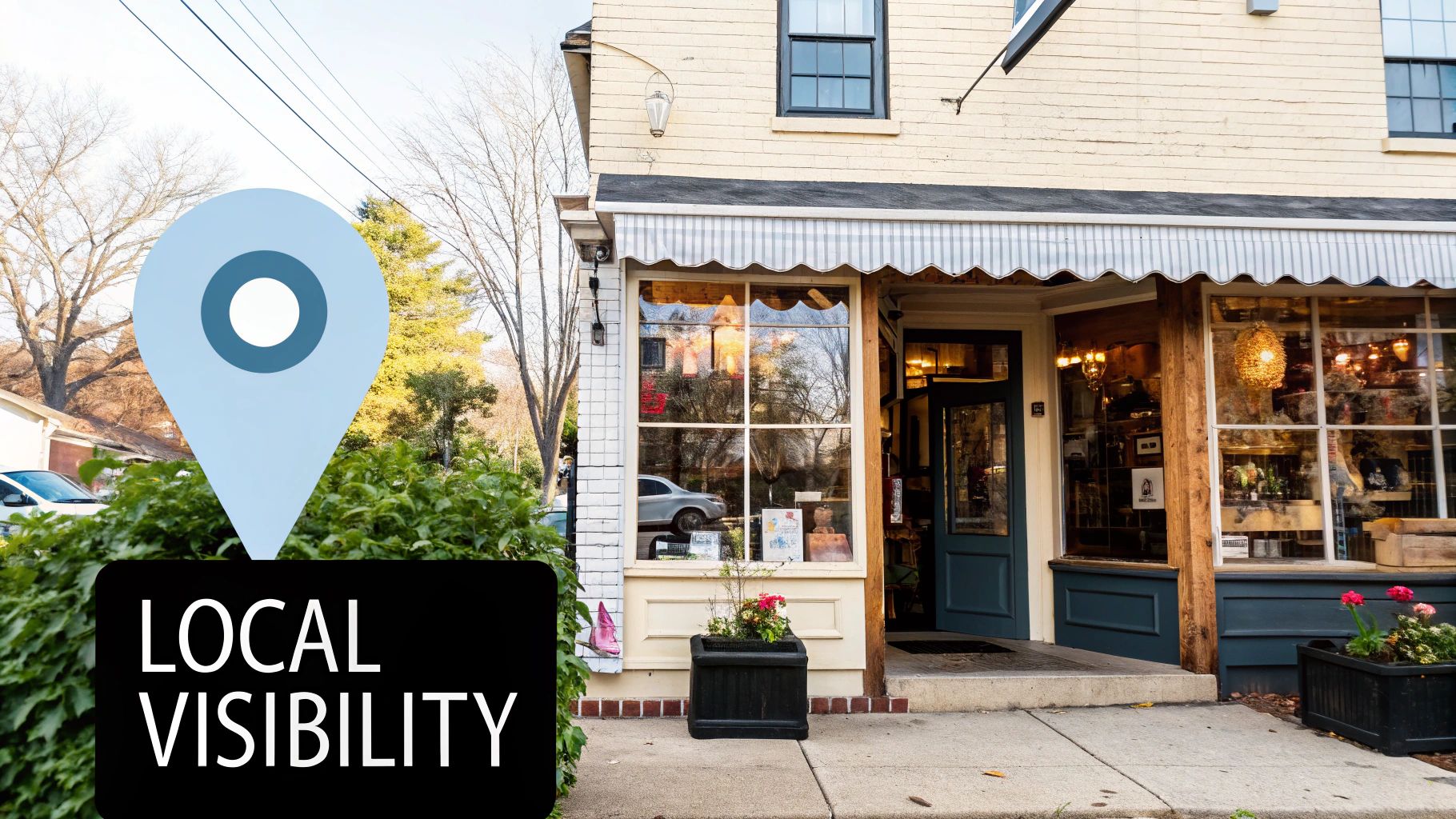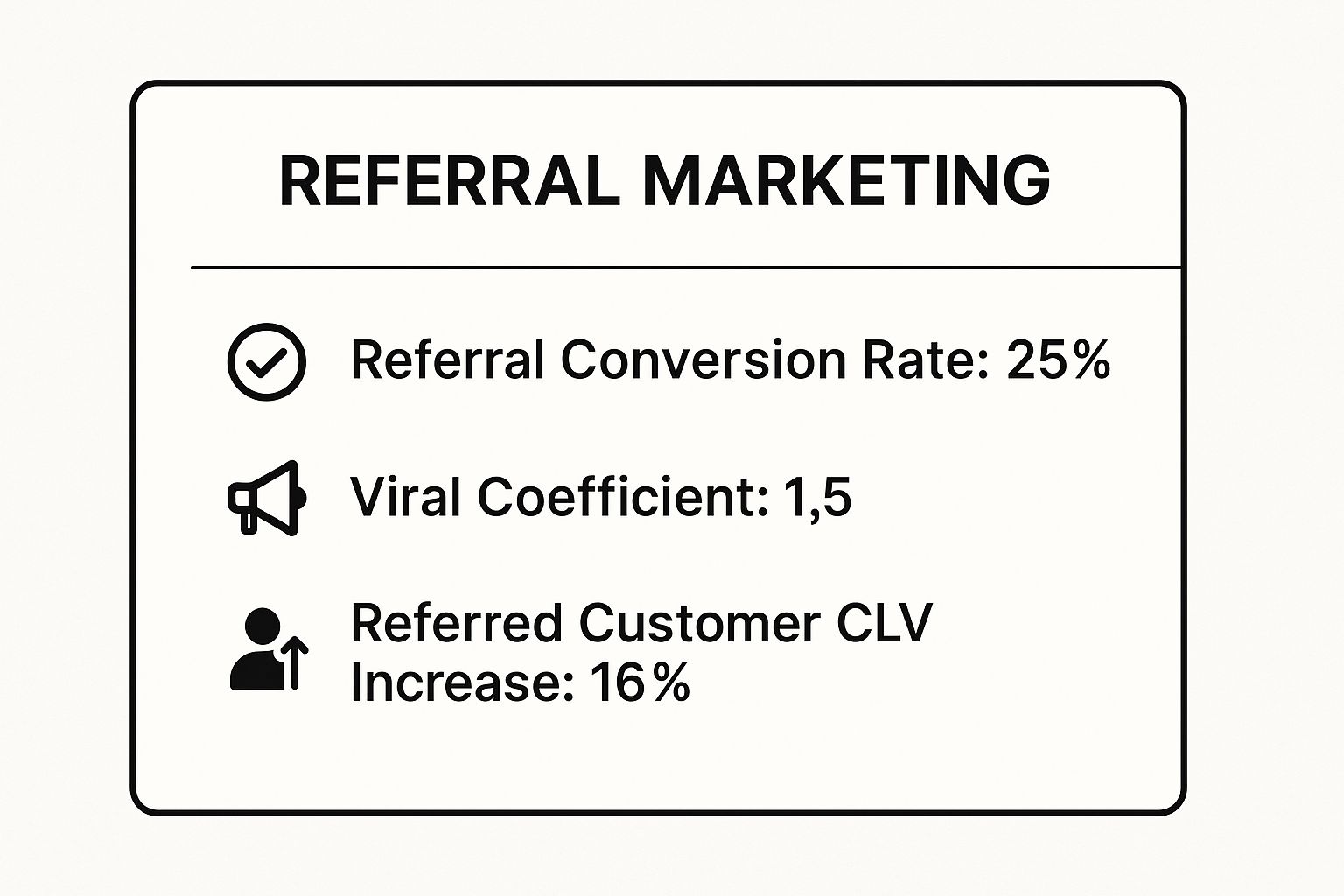Navigating the world of advertising can feel overwhelming for a small business owner. With limited budgets and even less time, every marketing dollar has to count, making the search for effective strategies a high-stakes endeavor. The good news? You don't need a massive budget or an in-house agency to make a significant impact. The most effective strategies today are about being smart, targeted, and creative, not just outspending the competition.
This guide cuts through the noise to bring you a comprehensive list of powerful and budget-friendly advertising ideas for your small business. We've compiled a playbook of actionable tactics that deliver real results, focusing on both digital and traditional channels that work in synergy.
From mastering local search with a finely-tuned Google Business Profile to leveraging the authentic voice of micro-influencers, these proven strategies will help you attract new customers, build lasting loyalty, and achieve sustainable growth. Forget generic advice; we're providing clear implementation steps and practical examples to get you started immediately. Let's dive into the advertising ideas that will transform your marketing efforts and drive your business forward.
1. Social Media Marketing
Social media marketing is a powerful and cost-effective advertising idea for small businesses, leveraging platforms like Instagram, Facebook, and TikTok to connect directly with customers. It goes beyond simple promotion; it’s about building a community, showcasing your brand’s personality, and driving targeted traffic through organic posts and paid ads. This approach allows you to engage in real-time conversations, gather customer feedback, and build lasting loyalty.
This method is ideal for businesses looking to build brand awareness and foster a direct relationship with their audience without a massive upfront investment. For example, a local bakery can use Instagram Stories to post daily specials, creating urgency and driving foot traffic, while a B2B startup can use LinkedIn to share industry insights and establish thought leadership.
How to Implement Social Media Marketing
To get started, focus your efforts rather than spreading yourself too thin.
- Platform Selection: Choose 2-3 platforms where your target audience is most active. A home decor brand might thrive on Pinterest and Instagram, while a financial consultant would likely find more success on LinkedIn and Twitter.
- Content Strategy: Develop a consistent posting schedule with high-quality visuals and videos. Mix promotional content with educational and entertaining posts to keep your audience engaged. For specific content inspiration to fuel your social media presence, explore these 9 Content Ideas Social Media Platforms Crave.
- Audience Engagement: Actively respond to comments, messages, and mentions. Sharing user-generated content is a fantastic way to build authenticity and make your customers feel valued.
- Paid Advertising: Start with a small budget for paid ads to test different audiences, creatives, and messaging. Platforms like Facebook offer incredibly detailed targeting options, allowing you to reach your ideal customers with precision.
By focusing on authentic engagement and providing value, you can turn social media into a primary driver of growth. For a more detailed guide, you can learn more about social media marketing ideas on sugarpixels.com.
2. Google My Business Optimization
Google My Business Optimization is a crucial, free advertising idea for small businesses that directly impacts visibility in local search. Now called Google Business Profile, this tool lets you manage how your business appears on Google Search and Maps. A well-optimized profile ensures you show up in the valuable "Local Pack" when potential customers search for products or services you offer nearby, driving highly qualified local traffic to your doorstep or website.
This method is essential for any business with a physical location or service area looking to attract local customers. For example, an optimized profile helps a plumber appear in urgent searches for an "emergency plumber near me," complete with a click-to-call button. Likewise, a retail boutique can showcase new inventory through photos, attracting local shoppers searching for specific clothing items.
How to Implement Google My Business Optimization
Getting started involves treating your profile as a dynamic and detailed hub for your business.
- Complete Profile Information: Claim and verify your listing, then fill out every single section. Businesses with complete profiles are considered more reputable by Google and are 70% more likely to attract location visits.
- High-Quality Photos and Videos: Regularly upload clear photos of your storefront, products, services, and team. Businesses with photos receive 42% more requests for driving directions on Google Maps.
- Encourage and Manage Reviews: Actively ask satisfied customers for reviews and make sure to respond professionally to all feedback, both positive and negative. Strong, positive reviews are a major local ranking factor.
- Use Google Posts: Share updates, offers, events, and new products weekly using the Posts feature. This signals to Google that your business is active and provides fresh content to searchers.
By keeping your profile accurate and active, you can dominate local search results. To explore this strategy further, you can learn more about digital local marketing on sugarpixels.com.
3. Content Marketing & Blogging
Content marketing is a strategic approach focused on creating and distributing valuable, relevant, and consistent content to attract and retain a clearly defined audience. For small businesses, this powerful advertising idea involves producing blog posts, guides, and videos that solve customer problems, positioning your brand as a trusted authority and driving organic search traffic. Instead of directly selling, you are providing value that naturally pulls customers toward your business.
This method is ideal for businesses aiming to build long-term trust, generate qualified leads, and improve search engine rankings without a recurring ad spend. For example, a pool installation company like River Pools and Spas saved its business by creating blog posts that answered every conceivable customer question, which in turn attracted highly qualified buyers. Similarly, HubSpot grew into a multi-billion dollar company by offering exceptional educational content on marketing and sales.
How to Implement Content Marketing & Blogging
A successful content strategy is built on consistency and a deep understanding of your audience.
- Keyword & Topic Research: Identify the questions and problems your target audience is searching for online. Use tools like Google Keyword Planner to find relevant keywords and focus on creating content that provides the best answers.
- Create High-Value Content: Develop in-depth articles, how-to guides, or case studies that are genuinely helpful. Focus on quality over quantity; one excellent, comprehensive post is more valuable than ten mediocre ones.
- Establish a Schedule: Create a content calendar to plan and publish consistently, aiming for at least 2-4 quality posts per month to build momentum with search engines and your audience.
- Promote Your Content: Publishing is only half the battle. Share your content across your social media channels, in your email newsletter, and within relevant online communities to maximize its reach.
By consistently creating content that educates and helps your audience, you build an invaluable asset that generates traffic and leads for years to come.
4. Email Marketing Campaigns
Email marketing is a highly effective advertising idea for small businesses, offering a direct line of communication to customers who have opted to hear from you. It involves building a list of subscribers and sending them targeted messages to nurture leads, promote offers, and drive sales. This strategy consistently delivers one of the highest returns on investment because you are connecting with a warm audience that has already expressed interest in your brand.
This method is perfect for businesses aiming to build long-term customer relationships and drive repeat business with minimal ad spend. For instance, a local gym can use an automated welcome sequence to onboard new members and share class schedules, while an e-commerce store like BarkBox sends personalized emails featuring a subscriber's dog by name to boost engagement and loyalty.
How to Implement Email Marketing Campaigns
To succeed, you need a strategy that focuses on value and personalization.
- Build Your List Organically: Offer a valuable incentive, or "lead magnet," like a free guide, checklist, or discount code in exchange for an email address. Avoid purchasing lists, as this can harm your deliverability and reputation.
- Segment Your Audience: Group subscribers based on their interests, purchase history, or engagement level. This allows you to send highly relevant content that resonates better than a generic blast.
- Focus on Value First: Follow the 80/20 rule: 80% of your content should be helpful, educational, or entertaining, while only 20% is promotional. This builds trust and keeps subscribers from hitting unsubscribe.
- Optimize and Automate: Write compelling subject lines to increase open rates and ensure your emails are mobile-friendly. Set up automated sequences for new subscribers to create a consistent and welcoming experience.
By treating your email list as a community, you can turn your inbox into a reliable revenue-generating channel. For more inspiration, you can see some great email marketing campaigns on sugarpixels.com.
5. Referral and Word-of-Mouth Programs
Referral programs formalize word-of-mouth marketing, turning your happiest customers into a powerful acquisition channel. This advertising idea for small business incentivizes existing clients to recommend your brand, creating a steady stream of highly qualified leads. It's built on trust; a recommendation from a friend is far more credible than a traditional ad, leading to customers with higher retention rates and lifetime value.
This method is perfect for businesses with a strong product or service and a base of satisfied customers. It leverages social proof to overcome initial skepticism and reduce acquisition costs. For instance, a local gym can offer a free month to both the referrer and the new member, while a SaaS company might provide account credits, similar to how Dropbox famously grew by offering extra storage space for successful referrals.
For a quick reference on why referral marketing is so effective, here are some key performance metrics often seen in successful programs.
These metrics highlight that referred customers not only convert at a high rate but also contribute significantly more value over their lifetime, making this a highly efficient growth strategy.
How to Implement Referral and Word-of-Mouth Programs
A successful program is simple for customers to use and rewarding for everyone involved.
- Make It Effortless: The referral process must be incredibly simple. Provide customers with a unique, one-click shareable link they can easily send via text, email, or social media.
- Offer Dual-Sided Incentives: Reward both the person making the referral and the new customer. This "give a little, get a little" approach increases participation and conversion rates. Rewards can be discounts, credits, or exclusive access.
- Timing is Everything: Ask for a referral at moments of peak customer satisfaction. The ideal times are immediately after a purchase, following a positive review, or when a customer reaches a significant milestone with your product.
- Promote Your Program: Don't expect customers to find the program on their own. Promote it actively through your email newsletter, on your website's thank-you pages, and within your app to ensure visibility.
6. Local Partnerships and Cross-Promotion
Local partnerships and cross-promotion are strategic advertising ideas for small business owners looking to expand their reach by teaming up with complementary, non-competing businesses. This approach involves pooling marketing resources and audiences to create mutually beneficial campaigns. It’s a powerful way to gain credibility and access new customers through trusted recommendations, all without a significant advertising spend.
This method is ideal for businesses with a strong local presence that want to build community and generate high-quality referrals. For instance, a gym could partner with a local nutritionist to offer a bundled wellness package, or a real estate agent could collaborate with a home staging company. Each business promotes the other to a relevant audience, creating a powerful, cost-effective growth loop.
How to Implement Local Partnerships
To start leveraging local connections, focus on building genuine, value-driven relationships.
- Identify Potential Partners: Look for businesses that share your target audience and brand values but offer a different service. A wedding photographer, for example, could partner with venues, florists, and planners to create a preferred vendor network.
- Create a Compelling Offer: Develop a joint promotion that provides clear value to both customer bases. This could be a bundled service, a co-hosted workshop, or an exclusive discount for referred customers. A local bookstore and a nearby café could co-host an author signing event.
- Establish Clear Terms: Create a simple written agreement outlining each partner's responsibilities, the promotion's duration, and how you will track results. This ensures everyone is aligned and accountable.
- Promote the Partnership: Actively promote your partner's business through your own channels, such as social media, newsletters, and in-store signage. Make it easy for them to promote you by providing ready-to-share content and marketing materials.
By enthusiastically supporting other local entrepreneurs, you can build a strong referral network that drives sustainable growth.
7. Video Marketing (YouTube & Short-Form Video)
Video marketing is a dynamic advertising idea for small business that leverages visual storytelling on platforms like YouTube, TikTok, and Instagram Reels to connect with audiences. It’s no longer optional; it’s an essential tool for capturing attention in a crowded digital space. This approach allows businesses to demonstrate products, share expertise, and build a more personal connection through engaging and easily digestible content.
This method is perfect for businesses aiming to build trust and authority quickly while boosting their search visibility. For example, a local real estate agent can use property tours on YouTube to reach a wider audience, while a software company can create short-form TikToks to explain complex features in a fun, accessible way. Video content is favored by algorithms and human audiences alike.
How to Implement Video Marketing
You don't need a Hollywood budget; your smartphone is powerful enough to start.
- Choose Your Platform and Format: Focus on where your audience spends their time. Use YouTube for in-depth tutorials and reviews, and use TikTok or Instagram Reels for quick, engaging, trend-driven content.
- Focus on Value First: Your primary goal should be to educate, entertain, or inspire. A local restaurant could create a short video showing the mesmerizing process of making fresh pasta, providing entertainment and a reason to visit.
- Optimize for the Platform: Hook viewers within the first three seconds, especially for short-form video. Add captions, as many users watch with the sound off. For YouTube, use keyword-rich titles, descriptions, and tags to improve searchability.
- Engage and Repurpose: Actively respond to comments to build a community. You can also repurpose a single long-form YouTube video into dozens of short clips, creating a wealth of content for other platforms from one initial effort.
8. Local SEO and Online Directory Listings
Local SEO is an indispensable advertising idea for small businesses that serve a specific geographic area. It involves optimizing your online presence to appear in local search results when customers search for your products or services "near me." Combined with consistent online directory listings on platforms like Google Business Profile, Yelp, and Apple Maps, this strategy dramatically increases your visibility to the most relevant, high-intent local customers.
This method is crucial for any business with a physical storefront or a defined service area, such as a restaurant, dental practice, or plumbing company. For example, when a potential customer searches for "best coffee shop in Brooklyn," a well-executed local SEO strategy ensures your cafe appears in the coveted Google "Local Pack" at the top of the results, driving immediate foot traffic.
How to Implement Local SEO and Online Directory Listings
A successful local strategy hinges on consistency and building local authority.
- Claim and Optimize Key Listings: Start by claiming and fully optimizing your free Google Business Profile. Then, ensure your business is listed on other core directories like Yelp, Bing Places, and Apple Maps. For a comprehensive overview of where you should be listed, Whitespark offers an excellent resource on the top citation sources for various industries.
- Ensure NAP Consistency: Your business Name, Address, and Phone number (NAP) must be identical across every single online profile, directory, and website mention. Inconsistencies can confuse search engines and harm your local rankings.
- Build Local Citations: A citation is any online mention of your NAP. Actively build citations by getting listed in local chamber of commerce websites, community blogs, and industry-specific directories.
- Encourage and Manage Reviews: Positive reviews are a major local ranking factor. Actively encourage satisfied customers to leave feedback on Google and other relevant platforms, and be sure to respond professionally to all reviews, both positive and negative.
9. Influencer and Micro-Influencer Partnerships
Partnering with influencers is a highly effective advertising idea for small businesses that uses social proof to build trust and reach new audiences. This strategy involves collaborating with individuals who have an engaged following to promote your brand. For small businesses, micro-influencers (10,000-100,000 followers) and nano-influencers (under 10,000 followers) are often the most impactful partners due to their high engagement rates, niche communities, and more authentic connections.
This approach is perfect for businesses aiming to build brand credibility and drive sales through word-of-mouth marketing in a digital format. For example, a small, eco-friendly coffee shop can gift products to local lifestyle influencers for an Instagram story mention, driving immediate foot traffic. Similarly, a new SaaS tool can partner with a tech micro-influencer on YouTube for an honest review, reaching a highly targeted and engaged audience.
How to Implement Influencer Partnerships
A successful influencer campaign requires careful selection and clear communication.
- Identify the Right Partners: Focus on relevance and engagement over follower count. A good engagement rate is typically between 2-5%. Use tools like HypeAuditor to vet potential partners for authentic followings and audience demographics that match your target customer.
- Start with Gifting: Before committing to a paid collaboration, offer to send free products in exchange for an honest review or post. This is a low-risk way to test the partnership and see if their content drives interest.
- Establish Clear Expectations: Create a simple contract or agreement outlining deliverables, compensation, usage rights, and timelines. This ensures both you and the influencer are aligned on the campaign goals. For small businesses looking to effectively tap into influencer collaborations, explore this complete guide to small business influencer marketing.
- Track Your ROI: Provide influencers with unique discount codes or trackable affiliate links. This allows you to directly measure the sales and traffic generated from each partnership, helping you identify your most effective collaborators for future campaigns.
Advertising Strategies Comparison for Small Business
| Marketing Strategy | Implementation Complexity 🔄 | Resource Requirements ⚡ | Expected Outcomes 📊 | Ideal Use Cases 💡 | Key Advantages ⭐ |
|---|---|---|---|---|---|
| Social Media Marketing | Medium – requires consistent content & platform management | Moderate – tools, content creation, ad spend | Brand awareness, engagement, targeted campaigns | B2C brands, lifestyle, retail, service providers | Cost-effective; precise targeting; real-time engagement |
| Google My Business Optimization | Low – initial setup and ongoing updates | Low – free platform, time for management | Improved local search visibility and foot traffic | Local businesses, physical stores, restaurants | Free; boosts local SEO; builds trust via reviews |
| Content Marketing & Blogging | High – ongoing content creation & SEO effort | Moderate to high – writing, tools, possible outsourcing | Long-term traffic, authority building | B2B, professional services, educational products | Builds authority; evergreen traffic; supports SEO |
| Email Marketing Campaigns | Medium – list building and campaign setup | Low to moderate – email platform fees and content creation | High ROI, direct customer communication | E-commerce, B2B services, subscription businesses | Exceptional ROI; personalization; highly measurable |
| Referral and Word-of-Mouth Programs | Medium – program design, tracking, and rewards | Low to moderate – software, incentives | High-quality leads, increased customer lifetime value | Businesses with loyal customers, SaaS, subscription | Low acquisition cost; builds advocates; scalable |
| Local Partnerships & Cross-Promotion | Medium – partner coordination and collaboration | Low – shared costs, event/material expenses | Shared audience reach, increased credibility | Local brick-and-mortar, retail, service providers | Cost sharing; access to new audiences; strengthens community |
| Video Marketing (YouTube & Short-Form) | High – equipment, production, editing skills | Moderate to high – equipment and potential outsourcing | High engagement, trust, and brand awareness | E-commerce, restaurants, fitness, education, personal brands | Highly engaging; preferred content type; SEO benefits |
| Local SEO & Online Directory Listings | Medium – technical SEO and listing management | Low to moderate – tools or professional help | Greater local search rankings and foot traffic | Local businesses, service providers, healthcare, retail | 24/7 lead generation; cost-effective long-term strategy |
| Influencer and Micro-Influencer Partnerships | Medium to high – research, outreach, contract management | Low to moderate – product gifting or paid posts | Authentic content, increased reach and trust | E-commerce, fashion, food, lifestyle, hospitality | High engagement; trusted recommendations; measurable ROI |
Putting Ideas into Action: Your Next Steps to Growth
You now have a comprehensive toolkit filled with powerful advertising ideas for small business owners, ranging from mastering local SEO with Google Business Profile to fostering community through strategic partnerships. We've explored how content marketing establishes authority, email campaigns nurture leads, and referral programs turn happy customers into your most effective sales force. The common thread woven through these diverse strategies is a focus on authentic connection and delivering genuine value.
The journey to effective advertising can feel overwhelming, but it’s crucial to remember that you don't need to implement every idea at once. The most successful campaigns are not born from trying to do everything, but from doing a few things exceptionally well. True growth comes from strategic implementation, consistent effort, and a willingness to adapt based on what the data tells you.
From Inspiration to Implementation
The key takeaway is to move from passive learning to active doing. Your next step isn't to build a dozen new campaigns overnight. Instead, it’s about making a strategic choice.
- Review and Prioritize: Look back at the list of advertising ideas. Which one or two strategies resonate most with your business goals and target audience? If you’re a local service business, optimizing your online directory listings and Google Business Profile might be the highest-impact starting point. If you sell a visually appealing product, diving into short-form video marketing could be your game-changer.
- Start Small and Measure: Choose one idea to focus on for the next 30 to 60 days. Define what success looks like for that single initiative. Is it more phone calls, increased website traffic, or a higher number of email subscribers? Set a clear, measurable goal and track your progress diligently. This focused approach prevents burnout and provides clear insights.
- Build Your Foundation: Many of these strategies, from content marketing to local SEO and influencer partnerships, drive traffic back to one central hub: your website. A professional, user-friendly, and conversion-optimized website is the non-negotiable foundation upon which all successful digital advertising is built. It’s where you convert interest into action.
Ultimately, mastering these advertising concepts is about creating a sustainable system for growth. It’s about moving beyond random acts of marketing and building an intentional, multi-channel engine that consistently attracts and retains customers. By choosing the right mix of tactics and executing them with focus, you transform your small business from a hidden gem into a recognized market leader. The power to grow is in your hands; start with that first focused step today.
A strong digital foundation is essential for converting the traffic these advertising ideas generate. If your website isn't ready to turn visitors into customers, your marketing efforts may fall flat. The experts at Sugar Pixels specialize in crafting beautiful, high-performance websites and executing digital marketing strategies that deliver measurable results for small businesses. Visit Sugar Pixels to learn how a professional online presence can amplify your advertising success.



